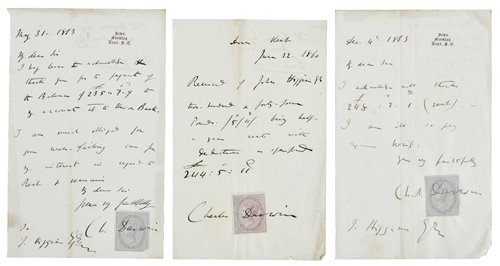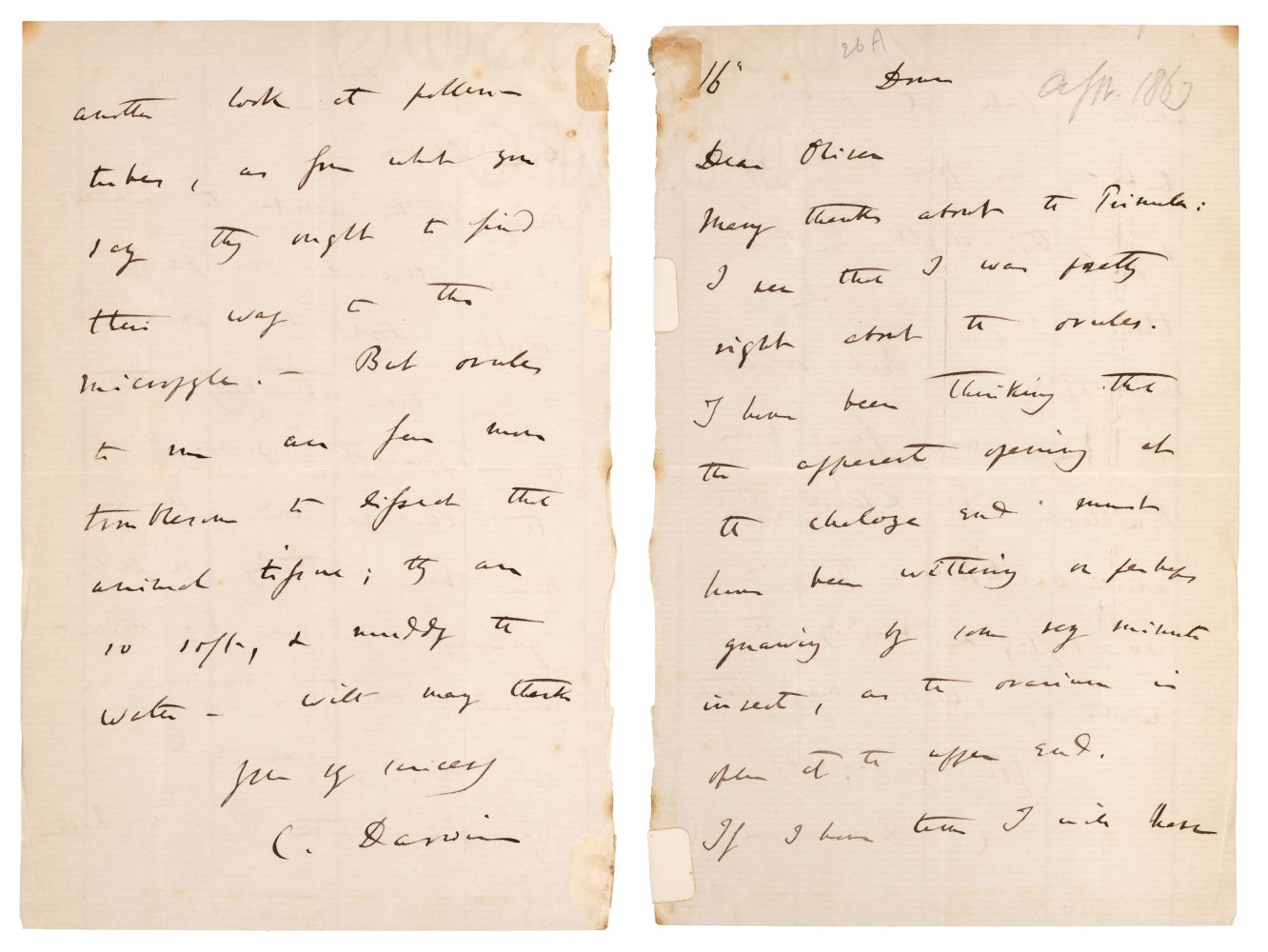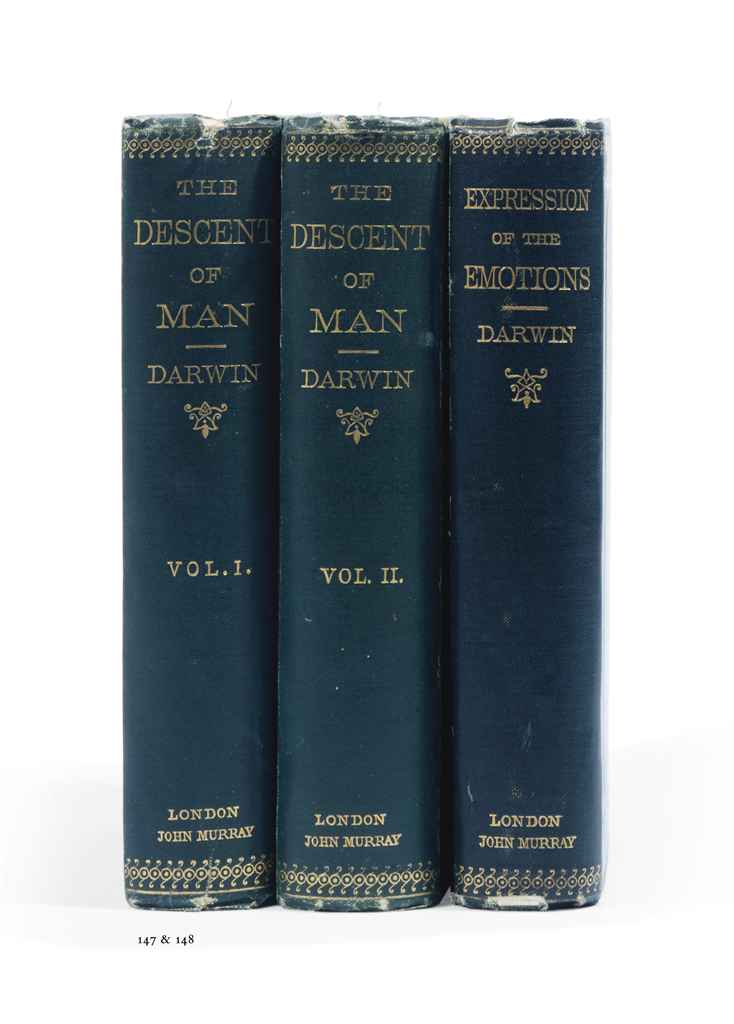Darwin (Charles Robert, 1809-1882). Letter signed, 'Ch. Darwin', Down, Bromley, Kent, S.E., 15 July [1866], to [Charles] Kingsley, written in the hand of Darwin’s wife Emma, thanking Kingsley for telling him where his lectures are published as ‘living in the country I might not have heard of their publication’, and that based on an abstract he saw in a newspaper he expects the lectures to much interest him, the rest of the letter being on the subject of the migrating eye in flatfish, ‘I can form no opinion about the wonderful case of the migration of the eye in flat-fish; whether Steenstrup is right who seems to think that the eye itself moves by absorption on one side and growth on the other; or whether Thompson [sic] is right who thinks that the eye itself does not move, but thinks that the adjoining parts are developed in a wonderfully unequal manner on the two sides of the head. The power of development on either side seems to me one of the most curious points of the case. When I read the paper I speculated how the unequal development c[oul]d have originated, and imagined that a fish feeding on the ground with its body held laterally might be benefited by the eye on the lower side becoming deeper and deeper imbedded in the skull, and instead of becoming blind and useless, travelling to the upper side, but this is all baseless speculation’, light creasing and one short split at upper margins, old tape adhesion marks at head and foot of first page (with some see-through) not affecting text, boldly signed ‘Ch. Darwin’ at foot of final page, 4 pages, 8vo Provenance: By family descent from the estate of Lady Mary Colyer-Fergusson (1871-1964) of Ightham Mote, Kent; and gifted to her by Mary Harrison in 1930. Mary Harrison (1852-1931), novelist and daughter of Charles Kingsley. Charles Kingsley (1819-1875) novelist, Church of England clergyman, social reformer and science populariser. An important, unpublished letter concerning the evolutionary problem of the migration of the eye in flatfish. It was written in response to the Rev. Kingsley's letter (12 July 1866), referring to the article by Charles Wyville Thomson, 'Notes on Prof. Steenstrup's views on the obliquity of flounders', published in the Annals and Magazine of Natural History for May 1865, in which Thomson gave an abstract, with commentary, of a paper by Japetus Steenstrup on the migration of the eye of flounders. Kingsley's letter is published in The Correspondence of Charles Darwin, vol. 14 and at The Darwin Correspondence Project (DCP-LETT-5154], where it is noted that it was acquired from [Kingsley’s daughter] Mary Harrison in 1930 (as the letter offered here). 'The DCP do not have knowledge of Darwin's reply yet. The DCP do not have any letters from Darwin on the migration of eyes in flatfish’. The two lectures delivered by Kingsley at the Royal institution that he draws Darwin’s attention to are ‘Superstition’ and ‘Science’, both published in Fraser’s Magazine, vol. 73, June 1866, pp. 705-16 & vol. 74, July 1866, pp. 15-28. Charles Darwin and Kingsley began to correspond soon after the publication of Origin of Species in 1859. Kingsley was a great science populariser and, arguably, as important as ‘Darwin’s bulldog’ Thomas Huxley in promoting Darwin's ideas, in spite of his own theistic beliefs. Indeed, Kingsley was one of 90 men to whom Darwin had asked his publisher John Murray to send an advance copy of his work. Kingsley was quick to respond and told Darwin that from his familiarity with the breeding of domestic animals he was quite prepared to embrace its thesis of transmutation. He added that he found it ‘just as noble a conception of Deity, to believe that he created primal forms capable of self development… as to believe that he required a fresh act of intervention to supply the lacunas wh[ich] he himself had made. I question whether the former be not the loftier thought’ (Kingsley, letter to Darwin, 18 November 1859; DCP-LETT-2534). Darwin went on to add
Darwin (Charles Robert, 1809-1882). Letter signed, 'Ch. Darwin', Down, Bromley, Kent, S.E., 15 July [1866], to [Charles] Kingsley, written in the hand of Darwin’s wife Emma, thanking Kingsley for telling him where his lectures are published as ‘living in the country I might not have heard of their publication’, and that based on an abstract he saw in a newspaper he expects the lectures to much interest him, the rest of the letter being on the subject of the migrating eye in flatfish, ‘I can form no opinion about the wonderful case of the migration of the eye in flat-fish; whether Steenstrup is right who seems to think that the eye itself moves by absorption on one side and growth on the other; or whether Thompson [sic] is right who thinks that the eye itself does not move, but thinks that the adjoining parts are developed in a wonderfully unequal manner on the two sides of the head. The power of development on either side seems to me one of the most curious points of the case. When I read the paper I speculated how the unequal development c[oul]d have originated, and imagined that a fish feeding on the ground with its body held laterally might be benefited by the eye on the lower side becoming deeper and deeper imbedded in the skull, and instead of becoming blind and useless, travelling to the upper side, but this is all baseless speculation’, light creasing and one short split at upper margins, old tape adhesion marks at head and foot of first page (with some see-through) not affecting text, boldly signed ‘Ch. Darwin’ at foot of final page, 4 pages, 8vo Provenance: By family descent from the estate of Lady Mary Colyer-Fergusson (1871-1964) of Ightham Mote, Kent; and gifted to her by Mary Harrison in 1930. Mary Harrison (1852-1931), novelist and daughter of Charles Kingsley. Charles Kingsley (1819-1875) novelist, Church of England clergyman, social reformer and science populariser. An important, unpublished letter concerning the evolutionary problem of the migration of the eye in flatfish. It was written in response to the Rev. Kingsley's letter (12 July 1866), referring to the article by Charles Wyville Thomson, 'Notes on Prof. Steenstrup's views on the obliquity of flounders', published in the Annals and Magazine of Natural History for May 1865, in which Thomson gave an abstract, with commentary, of a paper by Japetus Steenstrup on the migration of the eye of flounders. Kingsley's letter is published in The Correspondence of Charles Darwin, vol. 14 and at The Darwin Correspondence Project (DCP-LETT-5154], where it is noted that it was acquired from [Kingsley’s daughter] Mary Harrison in 1930 (as the letter offered here). 'The DCP do not have knowledge of Darwin's reply yet. The DCP do not have any letters from Darwin on the migration of eyes in flatfish’. The two lectures delivered by Kingsley at the Royal institution that he draws Darwin’s attention to are ‘Superstition’ and ‘Science’, both published in Fraser’s Magazine, vol. 73, June 1866, pp. 705-16 & vol. 74, July 1866, pp. 15-28. Charles Darwin and Kingsley began to correspond soon after the publication of Origin of Species in 1859. Kingsley was a great science populariser and, arguably, as important as ‘Darwin’s bulldog’ Thomas Huxley in promoting Darwin's ideas, in spite of his own theistic beliefs. Indeed, Kingsley was one of 90 men to whom Darwin had asked his publisher John Murray to send an advance copy of his work. Kingsley was quick to respond and told Darwin that from his familiarity with the breeding of domestic animals he was quite prepared to embrace its thesis of transmutation. He added that he found it ‘just as noble a conception of Deity, to believe that he created primal forms capable of self development… as to believe that he required a fresh act of intervention to supply the lacunas wh[ich] he himself had made. I question whether the former be not the loftier thought’ (Kingsley, letter to Darwin, 18 November 1859; DCP-LETT-2534). Darwin went on to add

.jpg)


.jpg)
.jpg)

.jpg)
.jpg?w=400)
.jpg)
.jpg)
.jpg)
.jpg)
.jpg?w=400)

Testen Sie LotSearch und seine Premium-Features 7 Tage - ohne Kosten!
Lassen Sie sich automatisch über neue Objekte in kommenden Auktionen benachrichtigen.
Suchauftrag anlegen